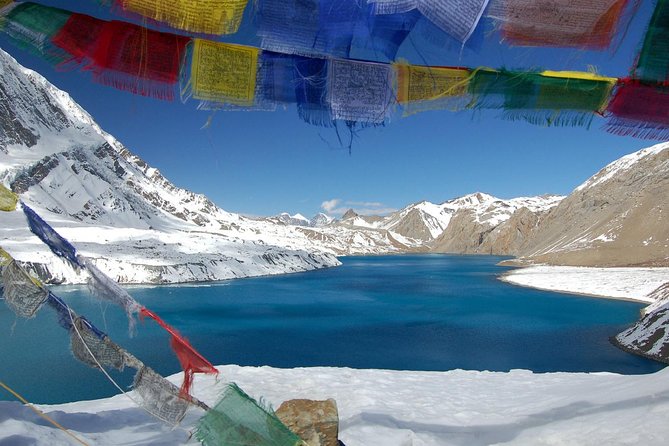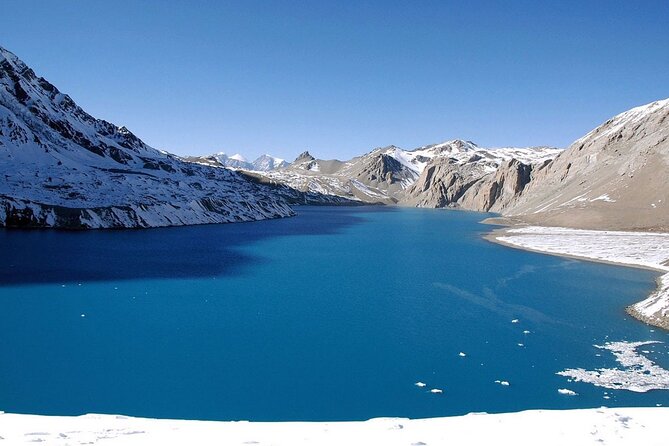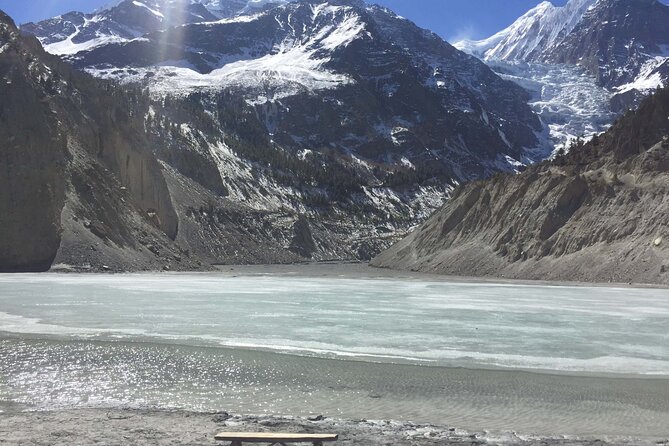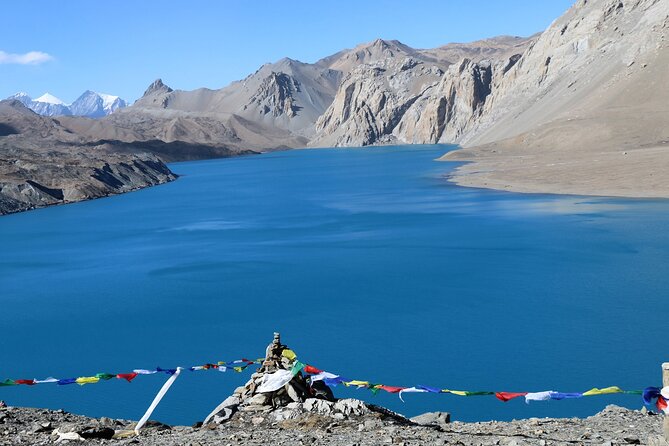The Annapurna Tilicho Lake Trek offers a unique blend of stunning landscapes and cultural richness, drawing trekkers into the heart of the Himalayas. Over the course of 17 days, adventurers face the challenge of crossing the Thorong La Pass while enjoying the hospitality of local lodges. Each step unfolds new vistas and experiences, but it’s the journey to Tilicho Lake, the highest lake in the world, that truly captivates. Many wonder about the best strategies for acclimatization and safety, which are crucial for a successful trek. What insights can enhance this unforgettable adventure?
Good To Know

- The Annapurna Circuit includes a trek to Tilicho Lake, the world’s highest lake, known for its stunning views and unique landscape.
- The trek features challenging sections, including the Thorong La Pass at 5,416 meters, requiring good physical fitness and acclimatization.
- Trekkers experience diverse scenery, from lush forests to high-altitude terrain, enhancing the adventure’s visual appeal.
- Local lodges provide cozy accommodation with traditional Nepali hospitality, making for a culturally immersive experience.
- An experienced trek leader guides the journey, ensuring safety, health monitoring, and insights into local culture and geography.
Trek Overview and Highlights

The Annapurna Tilicho Lake Trek is a breathtaking 17-day adventure that takes trekkers through the stunning landscapes of the Annapurna Circuit, culminating at the world’s highest lake, Tilicho Lake.
This trek, located in the Manang District of Nepal, features remarkable highlights including the challenging Thorong La Pass at 5,416 meters and panoramic views of the Annapurna and Dhaulagiri ranges.
Trekkers will experience diverse scenery, from lush forests and vibrant meadows to rugged high-altitude terrain.
Along the way, they’ll encounter local culture and hospitality, enhancing the journey’s richness.
With each step, the trek promises an unforgettable connection to nature, adventure, and personal achievement, making it a must for avid trekkers and nature lovers alike.
You can also read our reviews of more tours and experiences in Kathmandu.
Detailed Itinerary

Embarking on the Annapurna Tilicho Lake Trek offers a well-structured itinerary that guides trekkers through some of the most breathtaking landscapes in Nepal. The journey spans 17 days, featuring diverse terrains and stunning views.
| Day | Destination |
|---|---|
| 1 | Arrival in Kathmandu |
| 2 | Drive to Syange |
| 3 | Trek to Dharapani |
| 4 | Trek to Chame |
| 5 | Trek to Pisang |
As trekkers move through various elevations, from 1,100m to 5,416m, they experience unique scenery and cultural encounters. Each day’s trek ranges from 5 to 7 hours, allowing for ample exploration while ensuring acclimatization. This itinerary balances adventure and natural beauty seamlessly.
Accommodation Options

Accommodations during the Annapurna Tilicho Lake Trek are designed to provide comfort while immersing trekkers in the local culture. Trekkers can expect a mix of local lodges and guesthouses, which offer basic amenities and a cozy atmosphere.
Many of these accommodations feature traditional Nepali hospitality, allowing visitors to interact with the locals and experience the region’s culture firsthand.
In Kathmandu and Pokhara, trekkers enjoy more comfortable hotels with modern facilities. As the trek progresses, the lodges become simpler, reflecting the remote nature of the journey.
Each night, trekkers can unwind after a long day of hiking, sharing stories with fellow adventurers in a welcoming environment that enhances the overall trekking experience.
Meals During the Trek

Trekkers on the Annapurna Tilicho Lake Trek enjoy a variety of delicious and nutritious meals throughout their journey, ensuring they have the energy needed for each day’s adventure. Meals typically feature local ingredients and flavors, providing a taste of Nepali cuisine.
| Meal Type | Common Dishes |
|---|---|
| Breakfast | Porridge, eggs, toast |
| Lunch | Dal Bhat, noodles, soup |
| Dinner | Vegetable curry, rice, momos |
Each meal is prepared with care, often served in cozy lodges where trekkers can socialize and share stories. The trekking package includes breakfast, lunch, and dinner, making it convenient for participants to focus on their trekking experience without worrying about meal arrangements.
Transportation Arrangements
Transportation arrangements for the Annapurna Tilicho Lake Trek are designed to ensure a smooth and efficient journey for all participants.
The trek begins with a scenic tourist bus transfer from Kathmandu to Syange, providing stunning views of the Nepalese countryside. Throughout the trek, you will rely on local transportation options, such as jeeps or buses, to navigate between trailheads and key locations.
This combination of transport modes enhances accessibility and allows trekkers to focus on the breathtaking landscapes. For the return journey, another bus ride from Pokhara to Kathmandu completes the experience.
These well-coordinated transport options make the trek not only manageable but also enjoyable, ensuring that trekkers can enjoy the journey without logistical worries.
Guidance and Support
Guidance during the Annapurna Tilicho Lake Trek plays a significant role in ensuring a safe and rewarding experience. Trekkers will benefit from the expertise of an experienced, English-speaking trek leader, along with an assistant guide for every four trekkers.
These guides not only navigate the diverse terrain but also share valuable insights about the local culture and geography. They provide essential support, helping trekkers manage their pace and tackle challenging sections.
On top of that, they ensure safety by monitoring health conditions and offering tips to handle altitude challenges. With their knowledge, trekkers can focus on enjoying the breathtaking views and seeing the adventure, knowing they’re in capable hands throughout the journey.
Acclimatization Tips
Acclimatization is crucial for a successful Annapurna Tilicho Lake Trek, especially as trekkers ascend to higher altitudes.
To adapt effectively, trekkers should prioritize gradual elevation changes, allowing their bodies to adjust. It’s recommended to spend an extra day in Manang, engaging in light activities like short walks and exploring the area.
Staying hydrated is vital; trekkers should drink plenty of water to help alleviate altitude sickness symptoms. Eating well-balanced meals rich in carbohydrates can also support energy levels.
Observing one’s body for signs of altitude sickness is essential; if any symptoms arise, descending to a lower altitude is advised.
Safety Precautions

When embarking on the Annapurna Tilicho Lake Trek, prioritizing safety precautions is essential for a successful and enjoyable experience. Trekkers should always carry a well-stocked first aid kit, including altitude sickness medication.
Staying hydrated is crucial, so they should drink plenty of water throughout the trek. Using trekking poles can help maintain balance on uneven terrain and reduce strain on joints.
It’s also vital to heed weather forecasts and adjust plans accordingly, as conditions can change rapidly in the mountains. Trekkers should travel with a knowledgeable guide who can provide valuable assistance and support.
Lastly, everyone should ensure they’ve comprehensive travel insurance that covers trekking activities and emergencies. Safety first leads to unforgettable adventures!
Frequently Asked Questions
What Is the Best Time to Undertake the Annapurna Tilicho Lake Trek?
The best time for trekking usually falls between October and November or March and April. During these months, trekkers enjoy clear skies, moderate temperatures, and stunning mountain views, making their journey more enjoyable and rewarding.
Do I Need a Permit for the Annapurna Tilicho Lake Trek?
Yes, trekkers need a permit for the journey. They should obtain an Annapurna Conservation Area Permit and a Trekkers’ Information Management System card. These permits ensure safety and help preserve the region’s natural beauty.
How Physically Fit Do I Need to Be for This Trek?
For this trek, one needs moderate physical fitness. Daily hikes involve several hours of walking, often on challenging terrain. Regular cardio and strength training can help prepare, ensuring a more enjoyable and safe trekking experience.
What Gear and Equipment Should I Bring for the Trek?
For the trek, he should pack sturdy hiking boots, layered clothing, a warm sleeping bag, trekking poles, a first-aid kit, water purification tablets, and a reliable backpack to ensure comfort and safety during the journey.
Are There Any Communication Facilities During the Trek?
During the trek, communication facilities are limited. Most trekkers rely on mobile phones, but connectivity varies. Local teahouses may offer Wi-Fi, though it’s often unreliable, so planning ahead for communication is essential.
The Sum Up
The Annapurna Tilicho Lake Trek promises an unforgettable adventure filled with stunning landscapes and rich cultural experiences. Trekkers will find themselves immersed in the beauty of the Himalayas while enjoying the warmth of local hospitality. With careful planning, expert guidance, and a focus on safety, this trek is accessible for those seeking a challenge. Whether standing at the edge of Tilicho Lake or crossing Thorong La Pass, trekkers will undoubtedly create memories that last a lifetime.
More Hiking & Trekking Tours in Kathmandu
More Tour Reviews in Kathmandu
Not for you? Here's more nearby things to do in Kathmandu we have reviewed
- From Lukla: Everest Base Camp (EBC) 10-Day Trek
- Kathmandu : Everest Mountain Flight – with Private Transfers
- Full Day : Kathmandu Sightseeing By Bus Day Trip
- Kathmandu: 7 UNESCO World Heritage Sites Day Tour
- Kathmandu: 8-Day Langtang Valley Trek with Transfers
- Thamel Rickshaw Tour
- Everest View Motorbike Tour- 6 Days
- Kathmandu: Top 4 UNESCO Sites Private/Group Tour with Lunch
- From Oceans to Mountains-9 Days (Nepal Guided Tour)
- From Kathmandu: Everest Base Camp Helicopter Tour landings
- Kathmandu: Food and Drink Walking Tour
- Life and spirituality tour of Kathmandu
